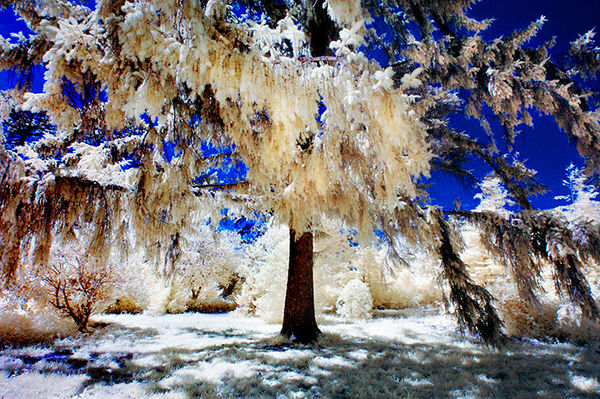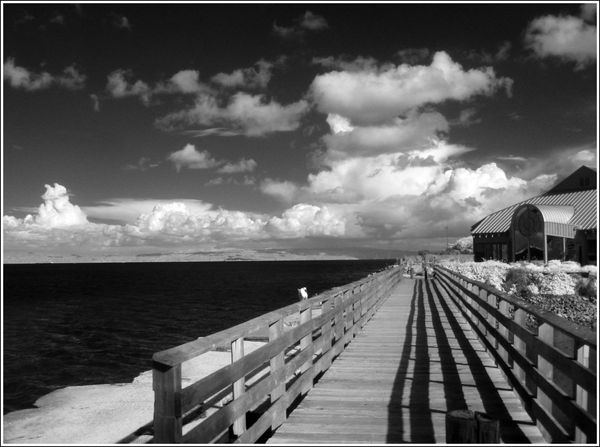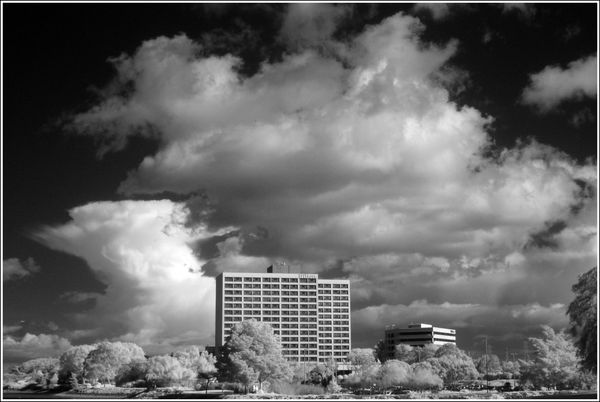Infra-red photography
Nov 3, 2014 06:22:00 #
I am intending on trying some IR pics this winter mainly landscapes, waterfalls etc and I would really appreciate any suggestions on which lens and brand of filter would be best for the subject matter. I am thinking of shooting in bright conditions to get maximum contrast. Many thanks
Nov 4, 2014 06:01:37 #
If you're shooting digital, you don't need any special lens or filters or anything else; just your camera. You can shoot color; then convert the image into regular black & white or infrared in photoshop. You'll get several benefits from this : You don't have to spend money on infrared filter or film. They're both quite expensive. Second, you get a lot better gray zone range (highlights to shadows range) when you convert from color to black & white or infrared. Third, even after converting the image to black & white or infrared, you can still tweak the image by moving the dial on red, green, blue, and yellow. Trust me, you get much better quality this way. I do it all the time. Even if you're shooting film, you still don't need extra accessories such as filters. You can scan the color image to a CD, download it and go from there. You can treat it like it was shot on a digital camera. If you want to see some samples, you can go fineartamerica.com, click on COMMUNITY, then click on ARTISTS AND PHOTOGRAPHERS, then type my name (BIJAN PIRNIA) in the rectangular box. You'll see quite a few regular and infrared black & white images all converted from color. No filter or infrared film was used. good luck to you.
Nov 4, 2014 06:53:53 #
Thanks very much Bijan I shall explore your suggestions.
Bijan M. Pirnia wrote:
If you're shooting digital, you don't need any spe... (show quote)
Nov 4, 2014 07:49:14 #
Bijan M. Pirnia wrote:
If you're shooting digital, you don't need any spe... (show quote)
You may get good results this way, but it's not infrared, it's a Photoshop imitation of the IR look. There's no such thing as "converting to infrared." There are some IR groups on the internet which specifically ban Photoshop IR.
Nov 4, 2014 08:38:07 #
wingclui44
Loc: CT USA
braindamage wrote:
I am intending on trying some IR pics this winter mainly landscapes, waterfalls etc and I would really appreciate any suggestions on which lens and brand of filter would be best for the subject matter. I am thinking of shooting in bright conditions to get maximum contrast. Many thanks
The best way to take IR picture is to convert your camera by removing the IR blocking filter from the sensor. but this is require pro. service and expensive. The cheaper way is use IR filter such as Hoya R72. I used it with a P&S bridge camera and got good result after PP with Photoshop. Here's a sample.

Nov 4, 2014 08:55:04 #
I have a camera that has been converted for IR photography. It is a full spectrum conversion which means that I have to supply a filter in front of the lens. This gives the ability to use 590 nm or 720 nm or even 850 nm for different effects. Photoshop can simulate a bit, but it is not the real thing and this is so much better.
What to watch out for are hot spots near the center of the picture. I have a lens that does this (the original kit lens). And the other lenses I have do not have this problem.
Also, I find that my auto focus is fooled and it shoots slightly out of focus. if I manually focus, the problem is solved.
The camera is a Sony A55. I find that all my older Minolta Maxxum lenses work just fine. And my newer lenses work fine too. Just not the original kit lens. But I also don't have filters to fit all of my lenses.
What to watch out for are hot spots near the center of the picture. I have a lens that does this (the original kit lens). And the other lenses I have do not have this problem.
Also, I find that my auto focus is fooled and it shoots slightly out of focus. if I manually focus, the problem is solved.
The camera is a Sony A55. I find that all my older Minolta Maxxum lenses work just fine. And my newer lenses work fine too. Just not the original kit lens. But I also don't have filters to fit all of my lenses.
Nov 4, 2014 09:08:40 #
Thanks John
JohnSwanda wrote:
You may get good results this way, but it's not infrared, it's a Photoshop imitation of the IR look. There's no such thing as "converting to infrared." There are some IR groups on the internet which specifically ban Photoshop IR.
Nov 4, 2014 09:09:05 #
I like your shot very much many thanks
wingclui44 wrote:
The best way to take IR picture is to convert your camera by removing the IR blocking filter from the sensor. but this is require pro. service and expensive. The cheaper way is use IR filter such as Hoya R72. I used it with a P&S bridge camera and got good result after PP with Photoshop. Here's a sample.
Nov 4, 2014 09:09:20 #
Thanks for the help.
JimH123 wrote:
I have a camera that has been converted for IR pho... (show quote)
Nov 4, 2014 11:16:12 #
I have been doing infra-red for more year as I can remember, first in film and now digital but I am only doing it in black and white. The only way to get great infrared id to have a camera converted. Clouds and green foliage are prime factors. I attach two images I did on Saturday and they were done with a cheap P&S Panasonic TZM3, 7.2 mega pixels converted to strictly B&W infrared.
IR is fun.
IR is fun.
Nov 4, 2014 11:35:52 #
braindamage wrote:
I am intending on trying some IR pics this winter mainly landscapes, waterfalls etc and I would really appreciate any suggestions on which lens and brand of filter would be best for the subject matter. I am thinking of shooting in bright conditions to get maximum contrast. Many thanks
I'm another advocate of converting a camera to IR. Many years ago, I used to shoot a lot of B&W IR film in 35mm and 4x5. I didn't like IR color film because it was just too far out, with the red skies and all. I also didn't like having to use a dark red filter for the B&W film which was very difficult to view and focus through, and having to use a tripod because of long exposures.
After I had switched to digital, and heard about IR converted cameras, I knew I had to try it. I also saw some examples of faux color IR with the blue skies from switching the red and blue channels, and I knew that's what I wanted to try. I got the enhanced color filter from Lifepixel, which let it some visible light so you can do color. It also does good B&W, lower in contrast than stronger IR filters, but I can increase contrast in post.
Here are some examples of my faux color IR:



Nov 4, 2014 13:12:32 #
wingclui44
Loc: CT USA
JohnSwanda wrote:
I'm another advocate of converting a camera to IR.... (show quote)
Love those color, the blue sky is brilliant!
Nov 4, 2014 16:19:13 #
JohnSwanda wrote:
Here are some examples of my faux color IR:
Here are some examples of my faux color IR:
The first one looks similar to an early morning pic I took in the '90s after a night of freezing fog. That analog photo was not IR and completely natural.
Nov 5, 2014 21:07:42 #
here's a ir shot, done with a nex c3 and a 590nm filter installed in camera...

Nov 5, 2014 21:35:32 #
GENorkus wrote:
The first one looks similar to an early morning pic I took in the '90s after a night of freezing fog. That analog photo was not IR and completely natural.
https://www.flickr.com/photos/87659272@N00/2500985668/
If you want to reply, then register here. Registration is free and your account is created instantly, so you can post right away.







